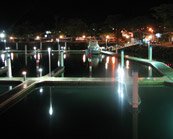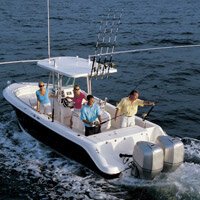Hi. I’m Keith, the Boating Guy…and today, I’m also the Fishing Guy!
If you’re like most fishermen, you’re always looking for new ways to hook the “Big One.” While I can’t promise you’ll come in with more fish than fish stories, I can talk about ways to tip the scales in your favor.
Since most fishermen own multiple rods and reels, let’s talk about where to stow your stuff first. To make the best use of space on your boat, outfit it with as many rod holders as you can.
Rod racks are meant to be placed on the side of the hull and can hold up to six rods horizontally. Tube style rod racks are mounted vertically on the sides of your boat’s console and take up very little space, while flush-mount rod holders need only a few inches of gunwale or gunnel to add rod storage to your boat. And if you’re wondering what a Gunnel is, it’s the top edge of a boat’s side that forms a ledge above the deck.
Now lets tackle tackle. What do you do with all those lures, bobbers, sinkers and other assorted weapons in your fishing arsenal? Tackle organizers are great alternatives to portable tackle boxes. These shallow plastic trays have different sized compartments that hold your lures and other gear securely in unused space on your boat.
If you prefer live bait, you’ll need a way to keep baitfish alive. Larger boats often have built-in baitwells—dedicated tanks with pumps and plumbing to provide the clean, aerated water baitfish need. For smaller boats, portable bait tanks are a good option.
Of course, to catch fish you need to find them. You and I both know that’s easier said than done. But a good fishfinder can help. A fishfinder is an electronic device that uses sound waves or SONAR to “see” under the water. By processing the sound waves, a fishfinder can determine water depth, submerged structures and just where those sneaky fish are hiding.
A fishfinder’s display shows you what the sonar is seeing. Displays vary by unit. Display resolution is measure in pixels—the higher the resolution the sharper the picture. Be sure to look for a unit with a display that works well in direct sunlight.
A fishfinder’s transducer sends out and reads the sonar sound waves. The sound waves radiate from the transducer in cone-shape, called a beam. A transducer with a wide beam width shows a larger area of the bottom in shallow water, while a narrow beam width works well in deeper water.
Fishfinder’s work best if they’re mounted in an area free of turbulent or bubbling water, like off to one side of the transom, and are installed perpendicular to the lake bottom.
Fishfinders can provide other useful information. Some models have sensors that read surface water temperature. Paddlewheel transducer equipped fishfinders provide fairly accurate boat speed, which is good to know if you’re trolling. Bottom hardness may be shown as a horizontal line on the display. Some models use fish icons to identify potential targets, however fish arches, which are formed as fish move through the sonar beam, offer a much more accurate way to tell the difference between weeds that look like fish and real fish.
Alarms that sound when you’re in shallow water can stop you from running aground or hitting bottom—which is easy to do when you’re concentrating on catching fish!
Now you know what you need to gear up for your next fishin’ mission—although you still might want to come up with a few stories about the “one that got away” just in case!
See Also:
- 30 Secret Fishing Tips
- 27 Ways To Tell If You’re A Fishing Fanatic
- Trolling Motors
- When To Fish
- Fighting A Fish
- Freshwater Fishing Tips
- Codes of Angling Ethics
- Freshwater Fishing Basics
- Fishing With Kids
- Where Do Fish Live?
- Discover Fishing
- Fishing Tips - Rod Storage
- Fly Fishing Boats
- What’cha Eating? Bait Matrix
- Flyfishing Essentials
- Freshwater Fish - Bass
- Ten Tips for Clean and Green Boating
- Finding the Right Freshwater Fishing Boat for You
- Freshwater Fish - Trout
- Freshwater Fish - Crappie
- Freshwater Fish - Northern Pike
- Fishing Accessories - Tips from the Boating Guy
- Freshwater Fish - Perch
- Choosing the Most Effective Freshwater Fishing Tactics
- Freshwater Fish - Catfish
- Freshwater Fish - Carp
- Selecting Your Freshwater Fishing Gear
- Freshwater Fish - Chain Pickerel
- Freshwater Fish - Walleye
- Freshwater Fish - Eel
- Freshwater Fish - Muskellunge
- Freshwater Fish - Drum
- Boating is Affordable

